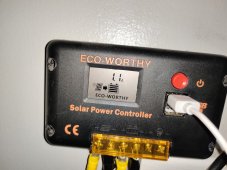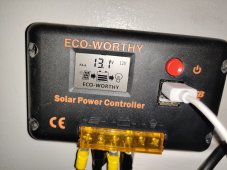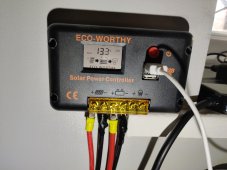Rednecktek
Solar Wizard
OK, so your controller is a PWM so realistically you will not see more than 75-ish watts out of it, but in direct clear sun each panel should be putting out about 5a. The controller is taking that 20v the panel is producing and cutting it down to the 14v the batteries want.
That is normal for a PWM controller.
What is NOT normal is that it's cutting it down to 12.6v which is "Almost Dead" for a battery, and only putting in 2.2a with 3 panels connected up.
Things to poke at:
1: Check the Batt+ and Batt- terminals with a meter, see what the voltage there is, it Should be about 14v give or take. If not, your SCC isn't doing its job.
2: Unplug and test each panel one at a time. If one panel is bad it could be nerfing the others. If you get about the same amperage on all 3 individually (3a for example) and then again when together (still 3a) then your SCC is shot. If one or more shows 0a in good sun then there's more testing that can be done.
3: I would HIGHLY recommend getting a proper MPPT controller. Even if the PWM is working perfectly, you're losing 25% of your panel's power Per Panel so best case you have effectively 3x 75w panels capability. You don't need a Victron or Outback, an EPEver or HQST or Rich Solar would be great, in a pinch PowMr will turn PV power into battery power just fine. If you can swing it, get a larger SCC than you need so you can grow into it in the future. Pro Tip: If it has USB ports on it, it's not MPPT, it's a dirty, dirty LIAR!
4: Lift up your panels! As a rule-of-thumb your panels should be at your latitude for best general year-round performance. If your panels are flat you're going to take another 30+% hit on performance. As an example, my camp is at 44deg N and change so I cut my frames at a 45deg because it's easy on the saw. They Should be tilted depending on the time of year but it's close enough to get real performance out of them. You can go outside at noon and point them directly at the sun and that's going to be about perfect.
EcoWorthy is pretty much the bottom of the barrel for quality so you're starting out at a significant disadvantage right out the gate. Add in that it's PWM and that's another big hit.
So let's add it all up on the napkin math here:
100w panel - 15% marketing factor = 85w
85w - 25% PWM inefficiency = 63.75w
63.75w panel - 30% for laying flat = 45w
45w panel * 3 panels = 135w of usable power, * 4 hours of sun = 535w per day of generation
135w / 14v = 9.5a that you SHOULD be seeing out of your SCC, not 2
So best case scenario you're almost breaking even on average.
IF you get a decent MPPT controller and get your panels tilted right napkin math:
100w panel - 15% marketing factor = 85w
85w - 5% cheap MPPT inefficiency = 80.75w
80.75w panel at the right angle = 80.75w
80.75w * 3 panels = 242w * 4 hours per day of sun = 969Wh
242w / 14v = 17.3a, or almost DOUBLE what your current setup can do.
Just for giggles and perspective, let's do "Perfect World" napkin math:
100w Panel * 3 = 300w
300w * 4 hours of sun = 1200Wh a day
300w / 14v = 21.4a to the batteries
Does that all make sense?
Did you ever find the No Load Draw for your inverter?
That is normal for a PWM controller.
What is NOT normal is that it's cutting it down to 12.6v which is "Almost Dead" for a battery, and only putting in 2.2a with 3 panels connected up.
Things to poke at:
1: Check the Batt+ and Batt- terminals with a meter, see what the voltage there is, it Should be about 14v give or take. If not, your SCC isn't doing its job.
2: Unplug and test each panel one at a time. If one panel is bad it could be nerfing the others. If you get about the same amperage on all 3 individually (3a for example) and then again when together (still 3a) then your SCC is shot. If one or more shows 0a in good sun then there's more testing that can be done.
3: I would HIGHLY recommend getting a proper MPPT controller. Even if the PWM is working perfectly, you're losing 25% of your panel's power Per Panel so best case you have effectively 3x 75w panels capability. You don't need a Victron or Outback, an EPEver or HQST or Rich Solar would be great, in a pinch PowMr will turn PV power into battery power just fine. If you can swing it, get a larger SCC than you need so you can grow into it in the future. Pro Tip: If it has USB ports on it, it's not MPPT, it's a dirty, dirty LIAR!
4: Lift up your panels! As a rule-of-thumb your panels should be at your latitude for best general year-round performance. If your panels are flat you're going to take another 30+% hit on performance. As an example, my camp is at 44deg N and change so I cut my frames at a 45deg because it's easy on the saw. They Should be tilted depending on the time of year but it's close enough to get real performance out of them. You can go outside at noon and point them directly at the sun and that's going to be about perfect.
EcoWorthy is pretty much the bottom of the barrel for quality so you're starting out at a significant disadvantage right out the gate. Add in that it's PWM and that's another big hit.
So let's add it all up on the napkin math here:
100w panel - 15% marketing factor = 85w
85w - 25% PWM inefficiency = 63.75w
63.75w panel - 30% for laying flat = 45w
45w panel * 3 panels = 135w of usable power, * 4 hours of sun = 535w per day of generation
135w / 14v = 9.5a that you SHOULD be seeing out of your SCC, not 2
So best case scenario you're almost breaking even on average.
IF you get a decent MPPT controller and get your panels tilted right napkin math:
100w panel - 15% marketing factor = 85w
85w - 5% cheap MPPT inefficiency = 80.75w
80.75w panel at the right angle = 80.75w
80.75w * 3 panels = 242w * 4 hours per day of sun = 969Wh
242w / 14v = 17.3a, or almost DOUBLE what your current setup can do.
Just for giggles and perspective, let's do "Perfect World" napkin math:
100w Panel * 3 = 300w
300w * 4 hours of sun = 1200Wh a day
300w / 14v = 21.4a to the batteries
Does that all make sense?
Did you ever find the No Load Draw for your inverter?
Last edited:






